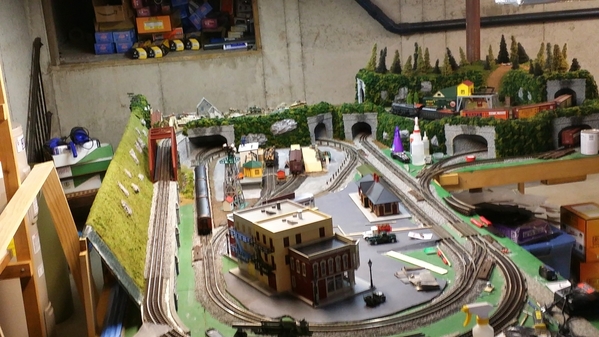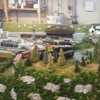Hello, considering adding a second level to My layout.Was curious as how to steep a grade modern MTH and Lionel diesels will go up with a few freight cars? I would have a climb of about 18 inches in 10 feet or so.Is this at all possible to do?
Replies sorted oldest to newest
Thats a 6.6% grade ! If you have traction tires on your locos and pull short trains you may get away with it on straight track but not on curves. Have you thought about building a helix to gain your needed elevation ? An O-42 circle of track gaining 4" per lap is a 3.3% grade a bit on ,what I consider, the high side but about what a Lionel trestle set creates. J
4% or less is good operating practice. Steeper than that and you're going to have problems.
For me, 6.6% would be out of the question.
Kinda depends on how many cars you want on your train. An engine will make that, but may only get a few cars up with it.
When used as directed, a classic Lionel 110 trestle set, yields a grade of around 5% average. The bents are actually designed with a slight bell curve shape for vertical transitions, so the D through H bents are slightly steeper.
Most of my layout is well under 4%, except for one small section which is deliberately steeper. I have two helixes, The big one is 10' in diameter, yielding around 2% grade on the outer track and 2.5% on the inner. The small helix is 8' in diameter, so the outer track is 3% and the inner track is 3.5%.
I regularly pull single engine trains with 12 -15 cars up both of them, no problem.
John, that 042 helix idea won't work, because you need to have at least 6" of vertical clearance for a train to pass under.
Attachments
Elliot, Two works of art, they look really sturdy, if you told me you parked a Volkswagon on top I would not doubt it. I did make an assumption that MAUTNER asking such a question was running smaller locos and cars and had rather limited space. The tallest scale size car I own is less than 4" tall so why would I need 6" of clearance ? I suppose if you have track that is near 1/2" thick sitting on 3/4" plywood + 4.25" for trains = 5.5" would be the minimum each loop would require. So, easy to see how you come up with 6", everyone loves a little fudge. However if you build it out of strips of metal you can keep the thickness of the support medium to basically no thicker than the ties. Using conventional Lionel tubular track the bottom of the rail sits directly on a cross arm and you need a cross arm about every 6". This with your vertical risers at 6" intervals effectively forms a cage that prevents derailed equipment from taking the dive into the floor. in most cases ! I haven't tried but seems simple enough to run a guard rail between the vertical risers for complete insurance against high dives. This concept has been in my head since 1957, I was ten and every kid on my block had trains and an Erector set. Two of my friends and myself combined our track and Erector sets and made just such a helix though we had to use a straight between each curve section to make the loops large enough and we could only make 3 loops the concept is the same. Made from the Erector set pieces the helix looked much like something you might see in New York city or the EL in Chicago. J
Rise over run. 18 inches divided by 120 inches is a 15% grade. You probably need to rethink how high you need to get. For o scale you need to get up around 7 inches to allow a train to pass under. I have roughly a 4 % and the modern locomotives can pull 15 freight cars comfortbly, good pullers can pull more, like 20 or more freight cars.
Also the biggest problem with steep grades is the transitions, which if too sudden causes engines to derail, so be sure to make the changes gradual.
Mautner, Pennsy484 is indeed right about this being a 15% grade and I was wrong saying it was a 6.6%. Sometimes when my lady friend calls to blow off steam, usually late at night that her daughter just doesn't appreciate her, I will sit there just saying uh huh every couple of minutes while I do something useful like reading O gauge forum. That is what was going on when I was answering your question seems I cannot divide and say uh huh at the same time. J
If you are going to run long cars, consider the effect transitions have on coupler alignment.
If you have a steep grade on a curve, and a big difference in the weight of cars, you may have string lining problems. Long cars coupled to short cars, heavy cars behind light cars, do not do well on heavy grades with curves.
Real railroads have to consider the same things. Regardless of anything else, if you have heavy grades, you will need to use more skill in handling the throttle, upgrade as well as downgrade.
You'll have no problem with a 6% grade. Here's a pic of my old layout. In the top pic, the rise on the left is a 6% grade. The train you see in the upper right of the pic is a Railking Mountain pulling 12 Atlas 10' reefers (because that's the limit of the reverse loop). The bottom pic is another view. I had ZERO issues with the grade even at 5 scale mph. I'm sure I could have pulled a 20 car train with that engine. As long as you have engines with a traction tire you'll be fine.
Hope this helps:
-Greg
Attachments
What type of engine, pulling what kind & type of cars on either straight & or curved track & how fast you like to run trains, adds into the equation.
Older Magnatraction engines and cars do best at 3% maximum, newer traction tire digitally controlled equipment will take a steeper 5-8% grade without breaking a sweat.
I run equipment usually around 20 - 30 mph. On my elevated track the trains are typically , engine pulling 4 -6 cars.This engine has both magnatraction and traction tires, conventional control.
Attachments
I had a tough grade, but I eased it: 2%, 4%, 6%, 8%, 6%, 4%, 2%. Worked!!
Everybody is wrong with the math so far.... Rise/Run is slope, not grade.
The grade is ATAN(18/120) = 8.53 degrees. Still too steep to be sure, keep it under 5%...
Grades and slopes are indicated in percentage. The arctan gives you the degrees. 15% slope yields an 8.53 DEGREE angle.
We're talking grades. See this link for an explanation: http://railroadboy.com/grade/
Well, you're right about the ATAN being 8.53°, but I think you're wrong about the definition since everything I've read basically says:
Grade, also referred to as slope, is the amount of incline of an elevation, for example the angle of the side of a hill. Grade can be expressed as the amount of rise over the amount of run, as a percentage, or as an angle measurement in degrees or radians.
8.53° is the angle of the incline and is fairly meaningless to most modelers. Most of us can relate to the 15% rise and how that compares to the suggested maximum of 5%.
5th grade was the hardest for me.
Chris Sheldon
The grade you are making is quite steep at that grade you may also encounter accidental decoupling as some ( I'll make up a name here, let's call it a post war lionel gondela) tend to uncouple as they are a tad lower than other couplers. I agree no steeper than 5%!










